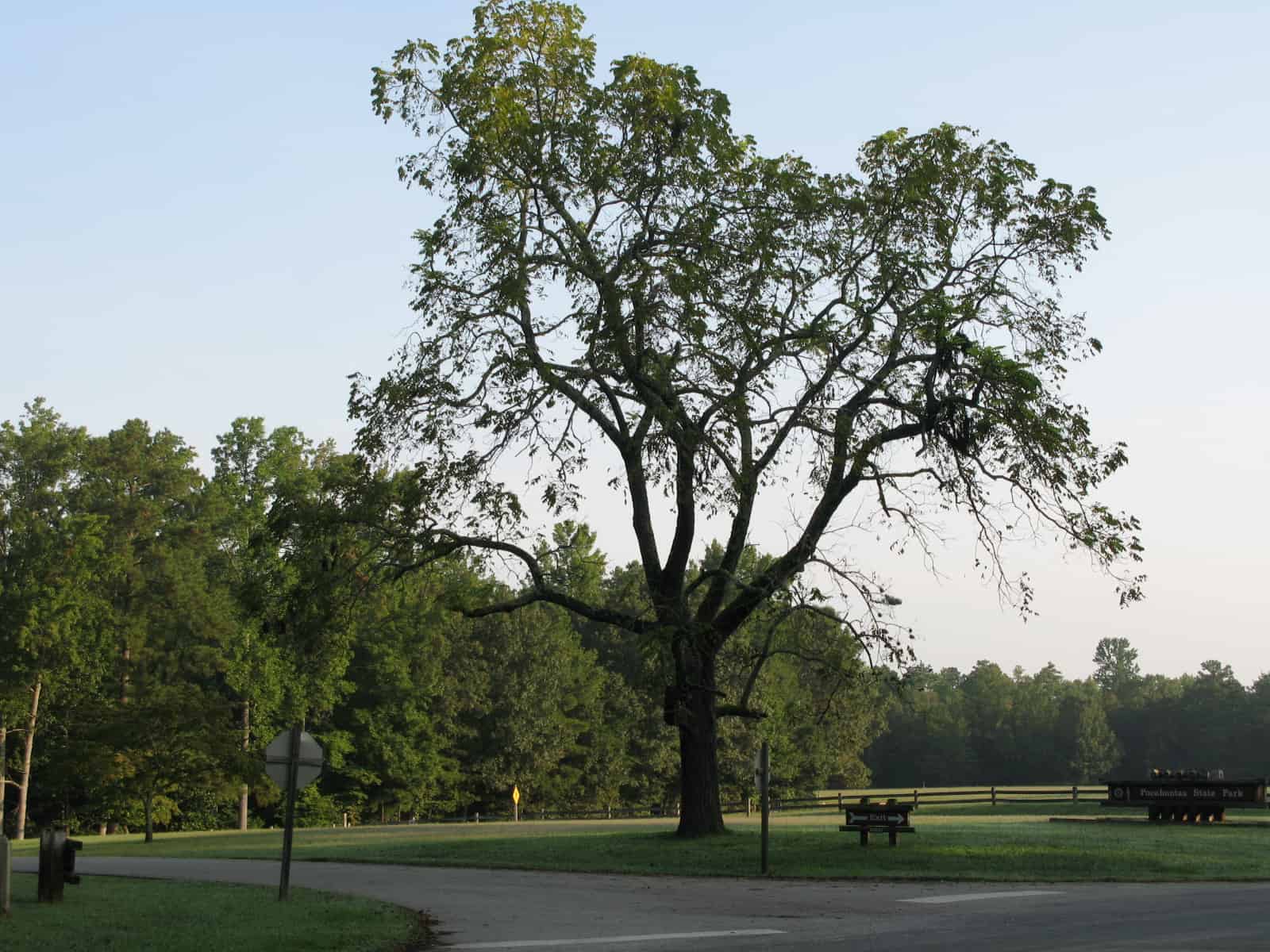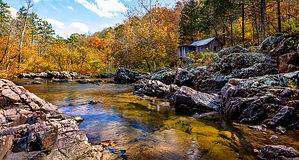Nestled in the heart of the American Midwest lies Iowa, a state known for its rolling cornfields and vibrant prairies. Yet, amidst this picturesque landscape, another unsung hero quietly thrives – native trees! These hardy botanical wonders have played a vital role in Iowa’s history, providing shade, shelter, and beauty to its residents for centuries.
In this article, we’ll embark on a journey through Iowa’s native trees, exploring their diverse species and rich contributions to the state’s environment and culture.
1. Bur Oak
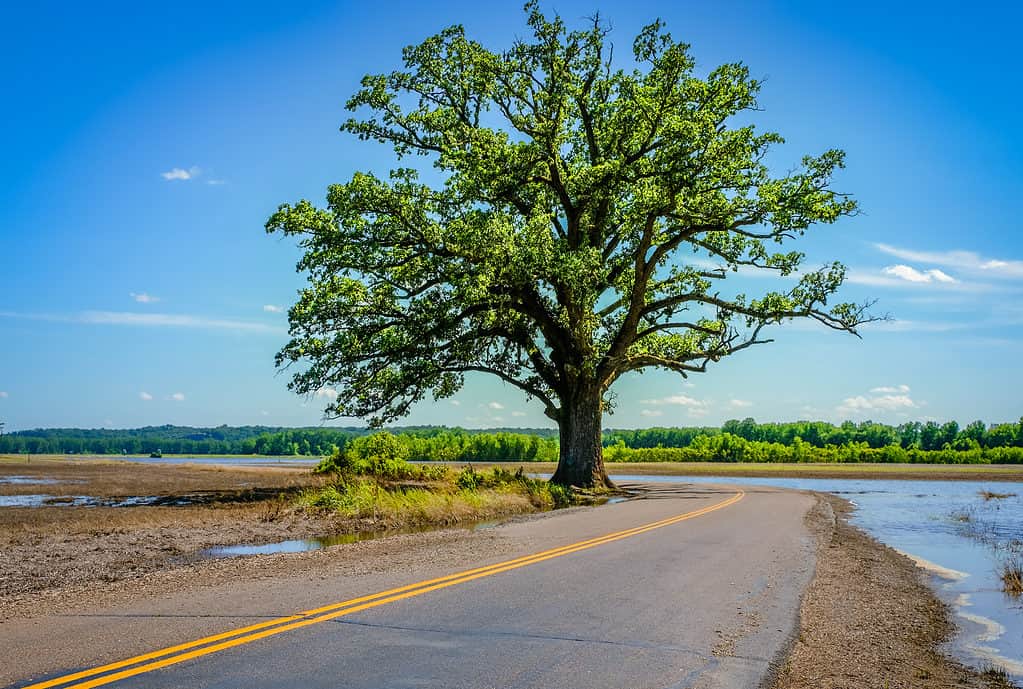
Bur Oaks are one of the most if not the absolute most fire-resistant oak trees in the world. It is often planted in areas where wildfires are difficult to control.
©LanaG/Shutterstock.com
The Bur Oak, scientifically known as Quercus macrocarpa, is a majestic tree native to the state of Iowa and various other parts of North America. This tree species is easily recognizable by its impressive stature. Mature Bur Oaks often reach heights of 70 to 80 feet. They possess a broad, spreading crown that can span up to 100 feet in diameter. Its deeply furrowed bark is grayish-brown in color, adding to its distinctive appearance. The leaves of the Bur Oak are lobe-shaped and have a glossy dark green color. They turn a brilliant shade of yellow-brown in the autumn.
Bur Oaks offers numerous ecological and practical benefits. They play a crucial role in the environment by providing shelter and food for various wildlife species. Their acorns are a valuable food source for squirrels, deer, and a range of birds. Thus, they are continuously contributing to the biodiversity of their habitat. Additionally, the extensive root system of the Bur Oak helps prevent soil erosion and improves water quality by filtering pollutants.
From a human perspective, Bur Oaks have in used for various purposes over the years. Native American communities used the acorns as a food source, grinding them into flour for making bread. European settlers, on the other hand, utilized the strong and durable wood of the Bur Oak for constructing buildings, making furniture, and crafting barrels. Today, the wood continues to be a prize for its exceptional strength and resistance to decay. These qualities make it sought after for a wide range of woodworking applications.
Also, these trees are highly valuable in urban landscapes for their aesthetic appeal and shade-providing abilities. The broad canopy of the Bur Oak offers relief from the summer sun and contributes to cooling urban environments, thus reducing energy consumption in nearby buildings.
2. Black Walnut Tree
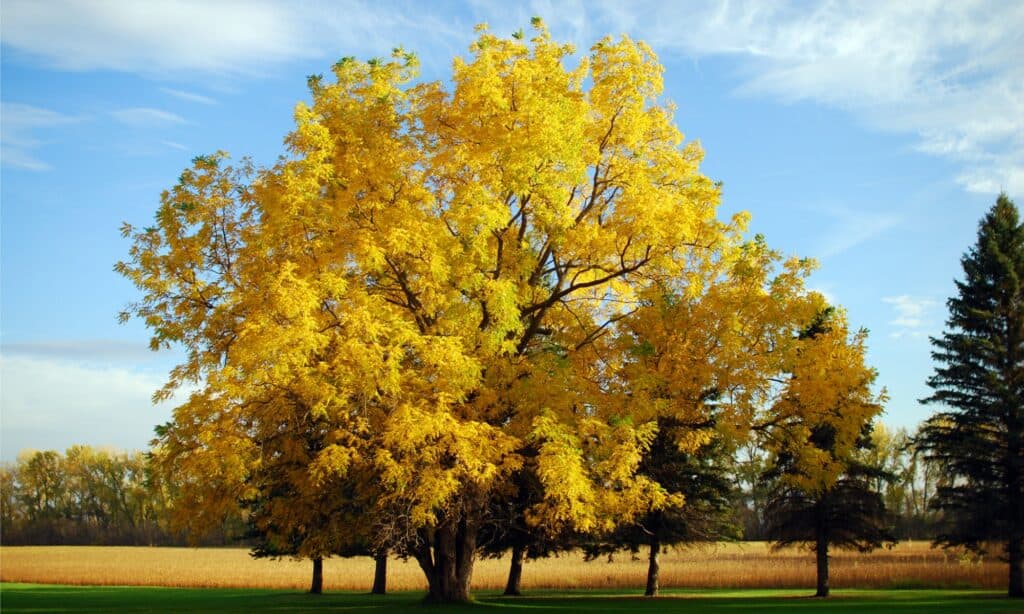
Black Walnut Trees produce nuts that are rich in antioxidants and other super-healthy compounds that are beneficial to human health.
©iStock.com/jdt01fgo
The Black Walnut tree, scientifically known as Juglans nigra, is a native tree species to the state of Iowa and various regions of North America. These trees are distinctive in appearance and have both ecological and practical significance.
Black Walnut trees typically reach heights of 50 to 75 feet, with a crown that forms a broad, rounded shape. They are recognizable by their pinnately compound leaves. These leaves consist of multiple leaflets arranged along a central stem. Their dark, deeply furrowed bark can appear almost black, giving the tree its name. In the autumn, their leaves turn a striking yellow-green to golden yellow, adding beauty to the landscape.
One of the notable benefits of Black Walnut trees is their contribution to the ecosystem. They produce nutritious nuts that are an important food source for wildlife such as squirrels, deer, and a variety of birds. This makes them valuable for supporting local biodiversity. Additionally, the trees’ extensive root systems help stabilize soil and prevent erosion, contributing to soil conservation.
From a human perspective, Black Walnut trees have multiple uses. The wood of these trees is a prize for its rich, dark color and durability. It is sought after for crafting fine furniture, cabinets, and veneers. The nuts, in a hard shell, contain a flavorful, oily “meat” and are often used in baking and cooking, imparting a unique and rich taste to various dishes and desserts. The wood also produces a natural substance called juglone. This substance can inhibit the growth of certain plants and weeds. This makes it beneficial in controlling unwanted vegetation in some areas.
In addition to their wood and nuts, Black Walnut trees are valuable for landscaping for their shade and aesthetic qualities. Their large, spreading canopies provide relief from the sun during hot summer months and create pleasant outdoor spaces.
3. White Oak
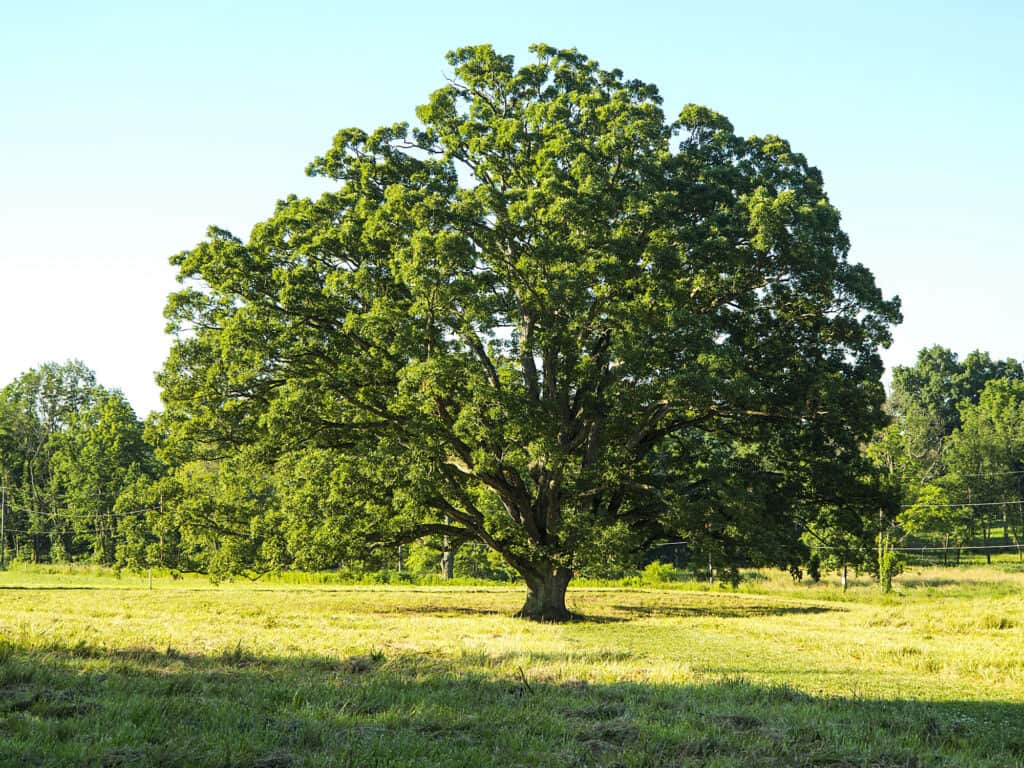
These oaks grow very slowly, which results in them growing only about a foot per year and living as long as 500 years.
©iStock.com/Cris Andrei
White Oak Trees, technically known as Quercus alba, are a significant and beloved component of Iowa’s natural environment and are native to the state. They are renowned for their unique look, valuable wood, and several advantages for the environment and humans.
These stately trees can reach impressive heights of up to 100 feet. It has a sturdy, straight trunk and a wide-spreading crown that provides ample shade. The leaves of the White Oak are distinctively lobed and have a deep green color. They turn shades of red and purple in the fall, which adds to their visual appeal.
White Oak trees offer several ecological benefits. Numerous animal species, including deer, squirrels, and other birds, depend on the acorns from these trees as a major source of food. As a result, it supports the wide variety of species that depend on local ecosystems for food. Additionally, White Oaks have a deep root system that contributes to the stability of the landscape by reducing soil erosion.
White Oak wood is sturdy, tough, and adaptable. Due to its extraordinary strength and ability to resist deterioration, it has long been used to build furniture, ships, and barrels. The wood’s fine grain and appealing appearance make it a popular choice for cabinetry and flooring as well. Additionally, White Oak is a favored material for cooperage, as it imparts a unique flavor to wines and spirits aged in oak barrels.
It’s also worth mentioning that White Oak trees are valuable in urban and suburban settings for their aesthetic appeal and their ability to provide cooling shade during the hot summer months, reducing energy consumption and creating comfortable outdoor spaces.
4. Shagbark Hickory

Shagbark Hickory bark is used for a variety of things, from making bows and arrows to smoking different types of meat.
©iStock.com/Ethan R.
The Shagbark Hickory tree, scientifically known as Carya ovata, is a native tree species to Iowa, adding to the state’s rich natural heritage. These distinctive trees are recognized for their unique appearance, valuable nuts, and various ecological and practical benefits.
Shagbark Hickory trees possess striking features. They typically grow to heights of 60 to 80 feet, with a straight and tall trunk. Their most distinctive characteristic is their bark, which peels away in long, shaggy strips, creating a rugged and textured appearance. The leaves of Shagbark Hickory are compound. They consist of several leaflets arranged along a central stem. They turn a vibrant yellow in the autumn, enhancing their visual appeal.
Ecologically, Shagbark Hickory trees are essential contributors to their native habitats. They produce hickory nuts that serve as a valuable food source for a wide range of wildlife, including squirrels, deer, and various birds. The nuts are rich in fats and proteins, making them a vital resource for animals during the colder months. In this way, Shagbark Hickory trees play a crucial role in supporting local biodiversity.
These trees offer practical uses as well. The wood of Shagbark Hickory is in high regard for its strength and flexibility. Historically, Native American tribes and early settlers used hickory wood to craft tools, handles for implements, and even bows for hunting. The wood’s exceptional properties also make it suitable for making furniture, flooring, and even musical instruments.
Moreover, Shagbark Hickory wood is valuable for smoking and flavoring food. The distinctive smoky flavor it imparts is sought after in culinary applications. It is particularly popular for smoking meats and enhancing the taste of various dishes.
5. American Elm
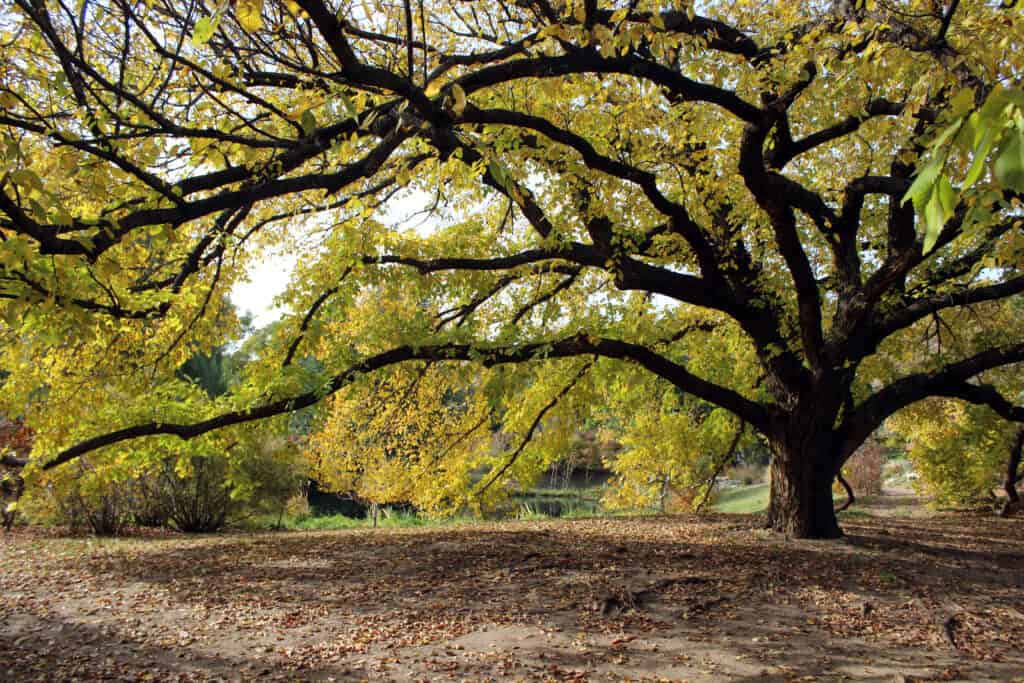
American Elms are also Water Elms.
©Aejahn/Shutterstock.com
The American Elm tree, scientifically known as Ulmus americana, is a native tree species to Iowa and many other parts of North America. It possesses a graceful appearance, an iconic vase-like shape, and various contributions to both the environment and human society.
These trees typically reach heights of 60 to 80 feet, with a symmetrical crown that forms an elegant vase shape. The leaves of American Elm trees are elliptical with serrated edges. They have a dark green color, turning various shades of yellow in the autumn. This autumnal transformation lends a striking visual quality to these trees.
One of the significant ecological benefits of American Elm trees is their role in providing habitat and food for various wildlife species. They produce small, round samara seeds that are a source of nutrition for birds and small mammals. Additionally, their dense canopies offer shelter and nesting sites for numerous bird species, contributing to local biodiversity.
In urban and suburban environments, these trees have aesthetic value and can provide shade. The broad, arching branches of American Elms create cooling and inviting spaces during hot summer months, making them popular choices for parks and residential areas. They have also been used to line streets, creating picturesque canopies along roadways.
Historically, American Elm wood was valued for its flexibility and durability. It was used in the construction of various items, including furniture, baskets, and even wooden water pipes. The wood’s flexible nature made it especially useful for creating wagon wheel hubs and boat ribs. However, the devastating Dutch elm disease, caused by a fungal pathogen, has significantly impacted these trees in recent decades.
6. Pecan
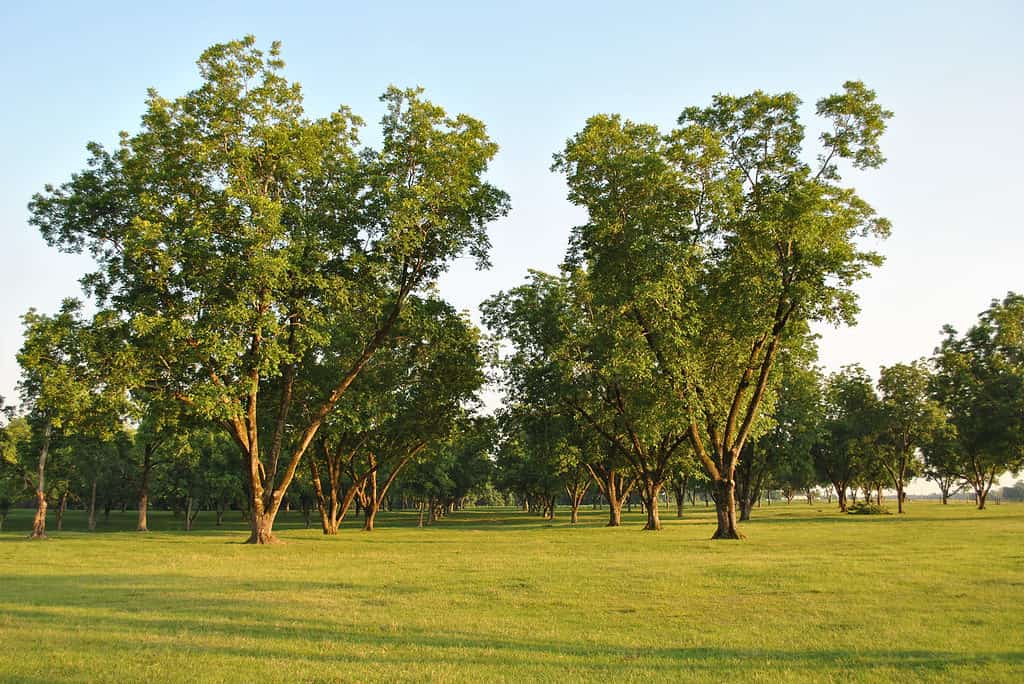
These trees are native to just a small region of Iowa.
©Tayloradempsey/Shutterstock.com
Pecan trees, scientifically Carya illinoinensis, are native to some parts of Iowa. They are typically in the southern regions of the United States, particularly in states like Texas, Georgia, and Oklahoma. These trees are valuable for their nuts, distinctive appearance, and various ecological and culinary uses.
Pecan trees are large and impressive, often reaching heights of 70 to 100 feet with a broad, spreading crown that can span up to 75 feet in diameter. Their leaves are pinnately compound, consisting of numerous leaflets that create a feather-like appearance. In the fall, these leaves turn brilliant shades of yellow and golden brown, adding to the tree’s visual appeal.
The most well-known benefit of pecan trees is their delicious and nutritious nuts. Pecans are a popular ingredient in a wide range of culinary applications, from pecan pies to savory dishes like roasted pecan-crusted chicken. These nuts are rich in healthy fats, antioxidants, and essential minerals, making them a sought-after addition to a balanced diet. Pecans also support local economies in regions where they are, contributing significantly to the agricultural industry.
In natural ecosystems, pecan trees provide habitat and sustenance for various wildlife species. Squirrels, in particular, are fond of pecans and play a significant role in dispersing the nuts, aiding in the regeneration of pecan forests. Pecan trees also offer shade and shelter for birds, making them valuable components of local ecosystems.
Just as well, pecan wood has practical uses. It is a prize for its beautiful grain patterns and is often for woodworking projects such as furniture and cabinetry. The wood is both sturdy and aesthetically pleasing, making it a favored choice among craftsmen.
7. Hackberry
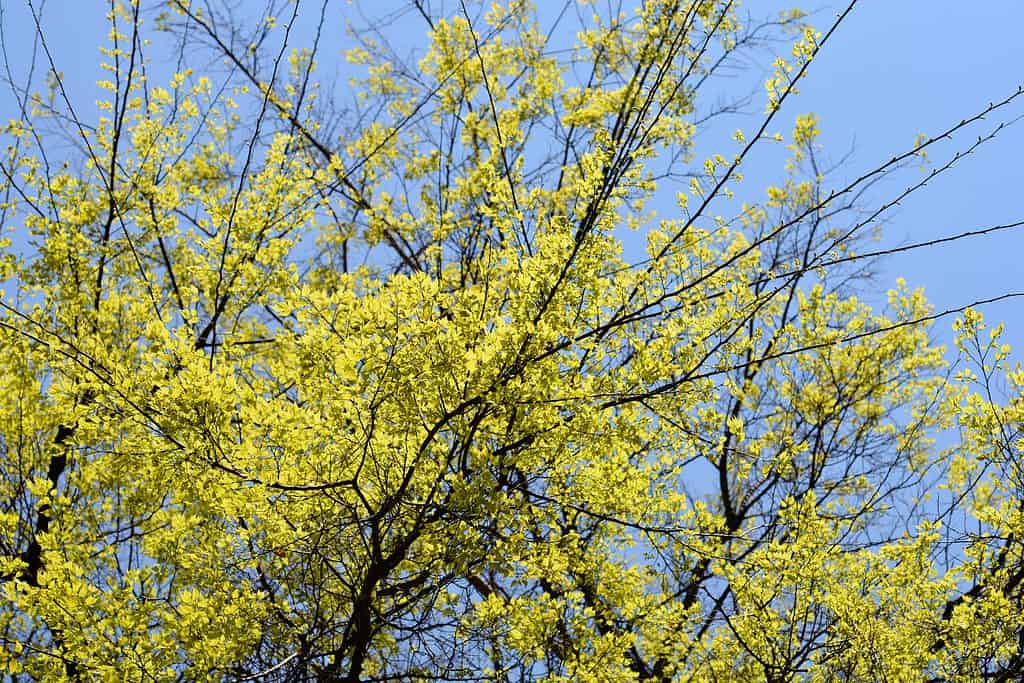
The berries are nutritious and edible.
©Nahhana/Shutterstock.com
Hackberry trees, scientifically known as Celtis occidentalis, are native to Iowa and many other parts of North America. These trees have distinctive characteristics and offer various ecological and practical benefits.
Hackberry trees typically grow to heights of 40 to 70 feet, with a rounded crown and a slender trunk. They are easily recognizable by their leaves, which are simple and alternate, with serrated edges. The leaves have a deep green color in the summer and turn to shades of yellow in the autumn, adding to the tree’s seasonal charm.
One of the notable benefits of hackberry trees is their role in supporting local wildlife. They produce small, berry-like fruits that serve as a food source for birds, including cedar waxwings and American robins. These fruits are an essential component of the diets of many bird species, contributing to the overall biodiversity of their habitats. Additionally, hackberry trees provide shelter and nesting sites for various birds, making them valuable for wildlife conservation.
From a human perspective, hackberry wood has been used in various ways throughout history. While not as prized as some other hardwoods, it is still useful for making furniture, crates, and handles for tools and implements. The wood is durable and resistant to decay, making it a practical choice for certain applications.
Hackberry trees are valuable in urban and suburban landscapes. They are useful for planting in a range of locations due to their tolerance to various soil types and temperatures. In the summer, its thick foliage offers shade, which helps with energy-saving by lowering the demand for cooling in neighboring buildings. Hackberry trees are a common selection for homeowners and landscapers because of their low care requirements as well.
Summary of the Most Iconic Trees Native to Iowa + More
| # | Tree | Maximum Height in Feet |
|---|---|---|
| 1 | Bur Oak | 100 |
| 2 | Black Walnut Tree | 100 |
| 3 | White Oak | 75 |
| 4 | Shagbark Hickory | 90 |
| 5 | American Elm | 80 |
| 6 | Pecan | 100 |
| 7 | Hackberry | 60 |
| 8 | Silver Maple | 80 |
| 9 | Black Oak | 70 |
| 10 | Sugar Maple | 75 |
| 11 | Boxelder | 50 |
| 12 | Northern Red Oak | 75 |
| 13 | Eastern Redbud | 30 |
| 14 | Sycamore | 100 |
| 15 | River Birch | 70 |
| 16 | Green Ash | 60 |
| 17 | Black Cherry | 80 |
| 18 | Chokecherry | 30 |
| 19 | Cottonwood | 100 |
| 20 | Quaking Aspen | 80 |
Thank you for reading! Have some feedback for us? Contact the AZ Animals editorial team.

